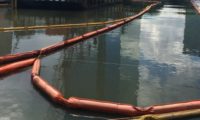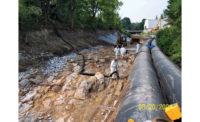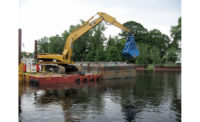As it previously had warned, New York state on Aug. 21 filed a federal lawsuit against the U.S. Environmental Protection Agency seeking to reverse its certification that General Electric Co.'s removal of PCBs from the Hudson River was complete, despite the agency’s five-year review finding that the cleanup was not adequate to protect human health and the environment.
New York asked the U.S. District Court in Albany to vacate the certificate of completion.
New York claims the seven-year, $1.7-billion cleanup of the upper Hudson River contaminated with PCBs from GE’s manufacturing operations at Hudson Falls and Fort Edward in New York is still incomplete, with studies showing PCB levels remain dangerously high in fish.
River disposal had been allowed for years, until PCBs were banned in 1979.
GE was required under the "record of decision" for the designated Superfund cleanup to dredge highly contaminated areas in the upper river.
The Hudson River cleanup site designation includes about 200 miles from Hudson Falls to the Battery in New York City. At issue is remediation of the upper Hudson River area from Hudson Falls to Troy, about 40 miles south.
GE dredged about 2.65 million cu yd of contaminated sediments. Recent studies show PCB contamination in Hudson River fish to be three times higher than the cleanup mandate objective, and “In fact, have remained largely unchanged in the three years since dredging ceased,” New York Attorney General Letitia James said.
About 54 tons of PCBs remain in the upper river, the state says.
The state Dept. of Environmental Conservation released a study in December showing elevated levels of PCBs remain in surface sediment of the river and PCB concentrations in fish were not recovering at the rate anticipated by EPA, Commissioner Basil Seggos said in April.
The state Dept. of Health also has issued advisories against fish consumption by children and women under 50 along the 200-mile stretch of the river.
"Since the EPA has failed to hold GE accountable for restoring the river, New York is taking action to demand a full and complete remediation," Gov. Andrew M. Cuomo said in a statement.
Pete Lopez, EPA’s regional administrator, said in April that the certificate of completion of the remedial action” confirms dredging and other work was properly performed, but the agency deferred determining the success of the remedy until more years of fish safety data are gathered.
GE must continue sediment and fish monitoring, and EPA does not expect to issue a final “certification of completion of work” for more than five decades, Lopez said.
EPA expects it will take about eight years of post-dredging sampling to establish a trend of decreased PCB levels in fish.
A GE spokesman noted in a statement that EPA's review determined no need for additional dredging. "New York state's data showed that 99% of locations sampled in the Upper Hudson met the cleanup standard that EPA and New York set," he said, adding that the firm still has active state-supervised remediation projects at its Hudson Falls and Fort Edward plant sites.
Meanwhile, progress on an estimated $613-million cleanup of PCB-contaminated soil and sediment by GE along the Housatonic River south of its former transformer factory in Pittsfield, Mass., awaits a mediation ruling after the firm appealed a 2016 EPA order.
A key cost issue is whether dredged contaminants will be sent to a nearby landfill or out of state.





Post a comment to this article
Report Abusive Comment